Businesses are in a dilemma.
A powerful online presence results in a high volume of inbound messaging at a time when customer care must be maintained at the highest standard.
And nowadays, people want to get responses in record time. So, companies are looking for smart solutions to handle multiple chats simultaneously using automation capabilities.
Let’s discover how to do it efficiently.
Manage multiple chats simultaneously with smart live chat tools
Three main problems with handling multiple chats at once
Let’s start by examining the main challenges support teams face when dealing with multiple chats.
Reduced response quality
In customer service, quality is more important than quantity. While handling multiple chats at once, it’s crucial to provide each customer with personalized and attentive support. This may become increasingly difficult in a high-volume environment.
Watch out for factors that can reduce the quality of your customer responses:
- Detail overload—when agents handle multiple chat conversations at once, they can easily lose track of the details specific to each customer
- Lowered personalization—juggling many chats makes it harder to personalize responses and keep a compassionate tone
- Losing context—failing to consider previous responses in ongoing conversations can frustrate customers
Increased stress and burnout
Stress and burnout are common among employees who perform repetitive tasks that could be easily automated. In fact, dealing with mundane, repetitive tasks is listed as one of the top five CS agents’ frustrations! They rob employees of valuable time and often lead to unhappy and disengaged employees, which can increase employee turnover.
Tasks that contribute to burnout often involve:
- High cognitive load—managing several chat requests at once requires constant mental switching, which can be exhausting and increase stress levels
- Pressure to respond quickly—the push to reduce response times can add to stress and lead to burnout if not managed properly
- Constrained budgets—especially during busy seasons, limited resources can overwhelm support teams
Coordination challenges
Handling multiple chats at the same time presents significant coordination challenges. Agents need to manage different conversations, each with its own context, tone, and urgency.
This poses following coordination challenges:
- Time management—spending too much time on one customer can cause delays for others, while not spending enough time may leave issues unresolved
- Technical difficulties—navigating between chat tools can be cumbersome and lead to errors
- Delays in resolving issues—when agents don’t have the authority to resolve an issue and need to escalate it to a senior, it can cause delays
So, just how do you handle multiple customers at the same time?
How to handle multiple customers at once
Spreadsheets and tools for tracking deadlines are a bit outdated for the needs of a modern customer support agents. Here are some strategies you can include into your workload to enable handling multiple chats at the same time effectively.
1. Use canned responses
Canned responses are predefined replies to commonly asked questions that agents can use when talking to customers, decreasing the response time and ensuring consistency. To create them, download chat transcripts, choose frequent questions raised by customers, and create responses in a friendly tone.
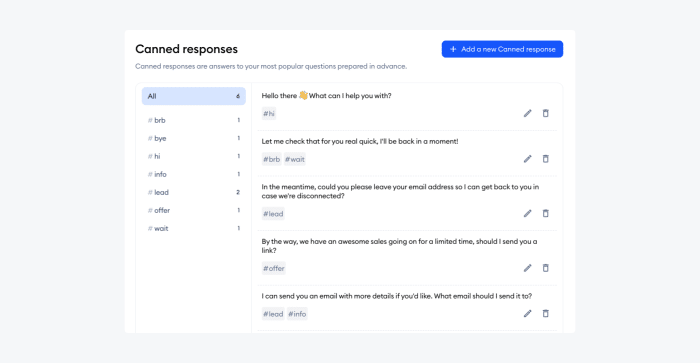
Predefined responses allow for providing consistent, accurate and quick information flow. And customers appreciate that too——there is a 7 times higher likelihood of meaningful engagement when a business responds to leads in under an hour.
2. Leverage live chat automation tools
You can use chat automation that solve finished live chat conversations for you. This decreases the amount of manual work for the agents, clears the inbox for new queries, and organizes the work better.
Another live chat functionality that can help you manage multiple chats at once is chat assignment. This lets you assign the incoming conversations to the specific operators.
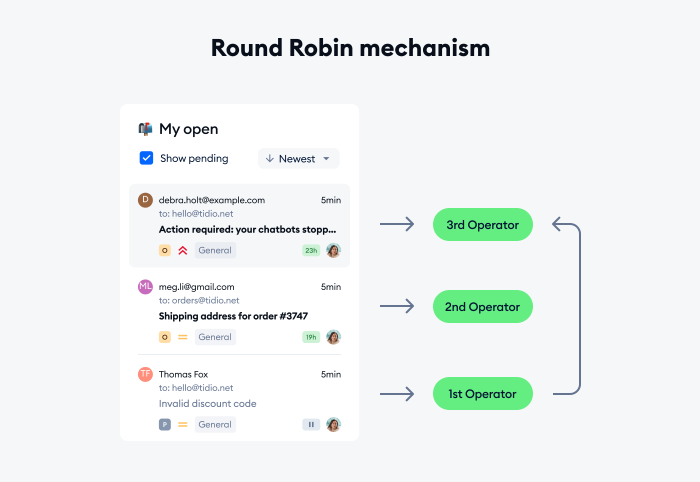
With Tidio’s chat assignment option, you can choose to do the assignment in two ways:
- Manually—all new chats will go to the Unassigned folder where operators can manually pick the conversations and assign themselves to the chats
- Automatically—Round-Robin automatically assigns conversations to the available operators in orderly manner
Did you know that…
Live chat has a big impact on your brand’s customer support. In fact, over 79% of customers prefer live chat over other communication channels due to the speedy responses.
3. Provide accessible self-service options
Support agents can use a well-organized knowledge base to quickly access standardized answers and detailed information. By utilizing search functions and categorization within the knowledge base, agents can swiftly retrieve relevant articles and troubleshooting steps. This, in turn, reduces response times and maintains high-quality interactions.
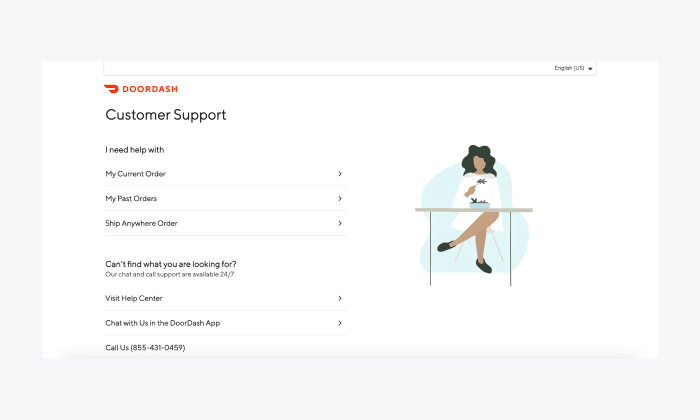
Here are some of the best practices for using an AI knowledge base when handling multiple chats:
- Proactively offer customer self-service options—direct customers to relevant resources, such as FAQs or video tutorials, when appropriate
- Utilize searchable knowledge bases—ensure the knowledge base is well-organized and has a robust search function for agents to quickly find and share accurate information
- Integrate all support tools—connect all of your self-service tools within the chat interface to reduce the need to switch between multiple platforms
4. Turn unsolved chats into tickets with helpdesk
Advanced ticketing system software can turn unsolved chats into tickets and route them to an appropriate department. This ensures the customer receives a timely answer to their inquiry and increases their satisfaction with your brand.

You can also connect an automated helpdesk to all of your other platforms to receive all communication in a single, shared inbox tool and escalate tickets to other departments with ease.
5. Use chatbots for repetitive queries
FAQ chatbots can serve as the first point of contact by handling routine queries, performing basic tasks, and quickly guiding users through troubleshooting or gathering initial information. This reduces the volume of inquiries, allowing support agents to focus on more complex issues that need personalized responses and critical thinking.
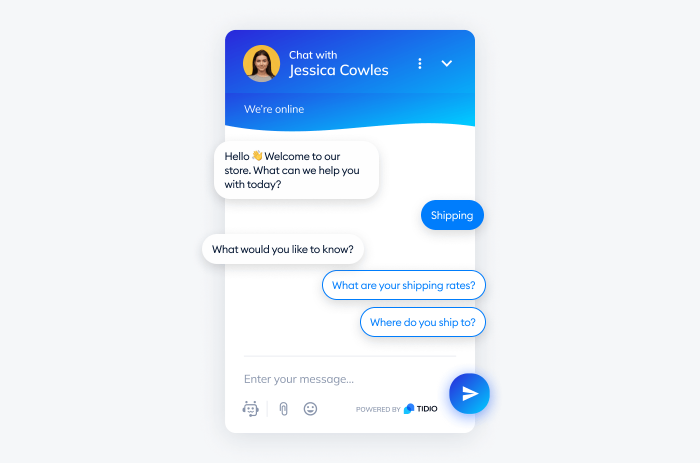
To streamline your workload, use chatbots to automate repetitive tasks like answering FAQs, responding to Instagram story reactions, and checking order status. Additionally, you can use AI chatbots to handle more complex interactions that requires a more detailed explanation and conversational tone.
Did you know that…
About 33% of customers stop buying from a brand due to poor communication.
Top five multichat platforms for businesses
Customers prefer getting quick solutions via chat instead of wasting time on phone calls. Multichat platforms let businesses provide just that by responding quickly and boosting satisfaction and conversions at the same time.
But which one should you choose from, given the many options on the market?
Don’t worry—
We’ve selected the top tools based on user reviews, features, and performance:
| Platform | Rating | Free plan/Free trial | Best for |
|---|---|---|---|
| Tidio | 4.7/5 ⭐️ | ✅ | Chat automations |
| HubSpot | 4.4/5 ⭐️ | ✅ | Lead generation forms |
| Zendesk | 4.3/5 ⭐️ | ❌ | Integrated voice support |
| WATI | 4.6/5 ⭐️ | ❌ | Broadcast campaign messaging |
| Google Chat | 4.6/5 ⭐️ | ✅ | Collaborative spaces |
Let’s check out the in-depth reviews of these solutions.
1. Tidio
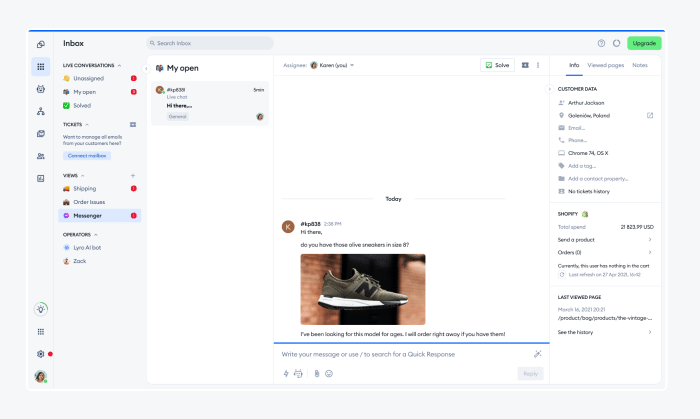
Rating: 4.7/5 ⭐️ (1,530+ reviews)
Tidio is perfect for managing multiple chats at once, making it ideal for online stores and service-based businesses looking to turn visitors into customers. With its shared inbox feature, Tidio merges live chat, email, helpdesk and social media messaging into one view, making it easy to handle several conversations efficiently.
Tidio also offers canned responses for quick, consistent answers to common questions and chatbots to automate routine tasks. This allows support agents to focus on more important conversations without getting overwhelmed.
Main features:
- Live chat feature
- Pre- and post-chat surveys
- AI and NLP chatbots
- Customizable chat widget
- Canned responses
- 7-day free trial available
- Free version available
- Starter ($24.17/mo)
- Growth (starts at $49.17/mo)
- Plus (starts at $749/mo)
- Premium (starts at $2999/mo)
Read more: Learn how to create a chat flow in multiple languages using Tidio. Also, check out how Gecko Hospitality achieved 90% customer service automation with Tidio’s software.
2. HubSpot
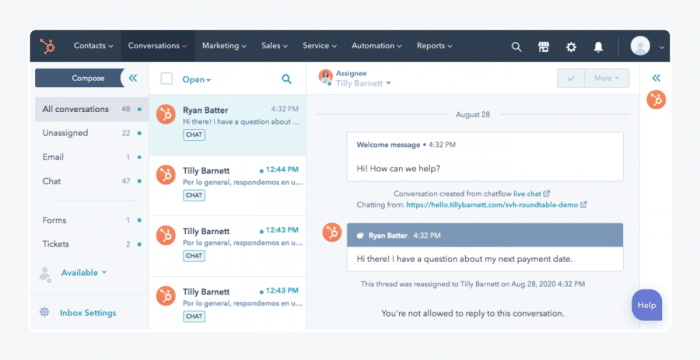
Rating: 4.4/5 ⭐️ (11,025+ reviews)
HubSpot is a multiple chat software you can use to handle customer conversations across various channels and platforms. This system allows for team collaborations on tickets and provides many integrations with communication platforms and social media channels such as Facebook Messenger.
Moreover, a live chat app allows for real-time conversations, while chat flows handle pre-set actions in the form of questions, quick replies, and knowledge base lookups. You can also send personalized messages according to customer profile and behavior to achieve an increase in engagement.
Main features:
- Multichannel inbox system
- Intuitive interface
- Lead generation forms
- Free version available
- Starter ($20/mo/seat)
- Professional Customer Platform ($1,180/mo)
- Enterprise Customer Platform ($3,910/mo)
Read more: Check out the in-depth reviews of the top HubSpot alternatives.
3. Zendesk
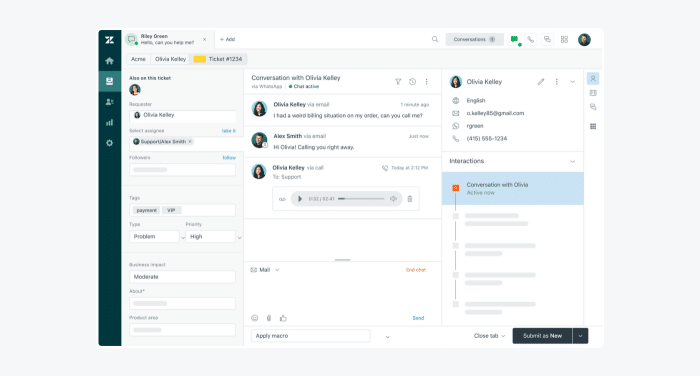
Rating: 4.3/5 ⭐️ (5,870+ reviews)
Zendesk is a software-as-a-service great for sales, customer support, and communications teams. This platform doesn’t require you to have any coding skills to integrate the chat widget code with your existing tool.
You can use the live chat and chatbot automations to provide personalized replies at scale, while giving your human agents a breather from repetitive tasks to effectively streamline workflows. Moreover, Zendesk’s AI agent can manage multiple chats, extract relevant information metrics from the knowledge base, and create personalized interactions.
Main features:
- Integrated voice support
- Ticket management
- Omnichannel support
- Free trial available
- Basic Plan ($19/mo/agent)
- Suite Team ($69/mo/agent)
- Suite Growth ($115/mo/agent)
- Suite Professional ($149/mo/agent)
- Suite Enterprise → contact sales team
Read more: Discover our top picks for the best Zendesk alternatives with pros, cons, and pricing compared.
4. WATI
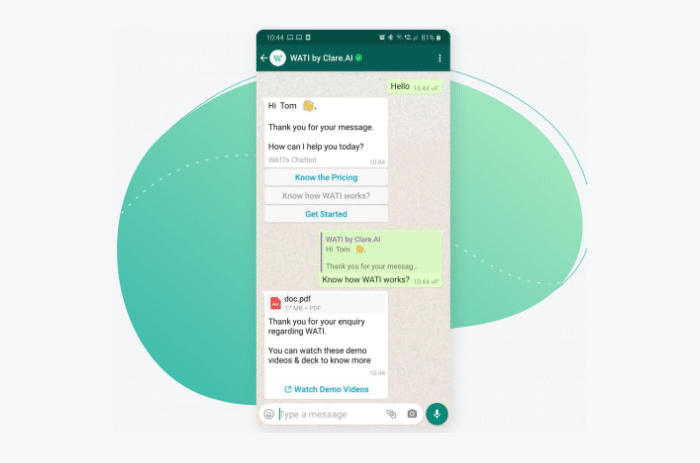
Rating: 4.6/5 ⭐️ (225+ reviews)
WATI is a must-have messaging tool for businesses operating on WhatsApp. It enables teams to conduct targeted campaigns through highly responsive WhatsApp messages. Additionally, WhatsApp chatbots can be easily deployed without any coding.
This WhatsApp automation app greatly improves the sales prospecting by engaging customers on their preferred platform. Whether you’re a small startup utilizing HubSpot, Zapier, or Google Sheets, you can effortlessly integrate the pre-built WATI plugin and start using it immediately.
Main features:
- Easy to use chatbot builder
- Shared team inbox tool
- Broadcast campaign messaging
- Growth ($49/mo/5 users)
- Pro ($99/mo/5 users)
- Enterprise ($299/mo/5 users)
5. Google Chat
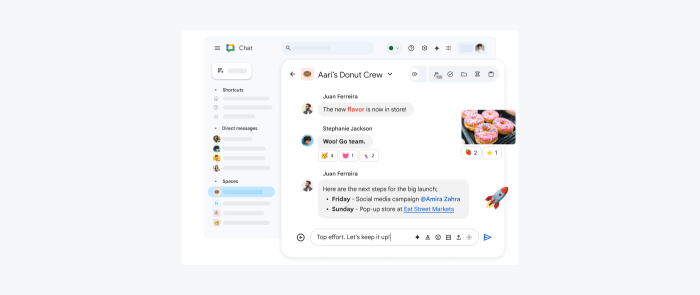
Rating: 4.6/5 ⭐️ (2,375+ reviews)
Google Chat is an internal tool designed specifically for customer support teams using Google Workspace. It offers seamless instant messaging similar to Microsoft Teams or Slack, enhancing collaboration among team members. Support teams can chat via text, collaborate in dedicated chat rooms, share documents, present ideas, and run web conferences.
With AI-powered assistance from Gemini, team members can quickly get answers to queries, find files in Google Drive, and brainstorm more effectively. The platform also includes features like GIFs, reactions, and emojis to make communication more engaging. Additionally, this multichat software integrates smoothly with popular tools like Jira, Asana, and Zapier, and is accessible on both iOS and Android devices.
Main features:
- Collaborative Google spaces
- GIFs, reactions, and emojis available
- API and Integration with popular apps
- Starter ($6/mo/user)
- Standard ($12/mo/user)
- Plus ($18/mo/user)
- Enterprise → contact sales team
Read more: Examine the must-have chatbot features for customer support with real-life examples.
Key takeaway: run multichat via live chat automation
Almost every major brand online has a live chat section where customers get to directly engage with the support team. Software, such as live chat, chatbots, and automated helpdesk systems help your agents manage multiple conversations at once.
The main strategies for handling multiple chats at the same time include:
- Using canned responses
- Leveraging advanced live chat features
- Providing accessible self-service resources
- Turning unsolved chats into tickets
- Using chatbots for repetitive tasks
It’s not easy for support agents to handle multiple chats simultaneously and maintain quality. But adopting technology that harnesses canned responses, knowledge base integrations, and customer routing helps to optimize yet enhance output.
Tidio offers all of the above, and then some more.
Why not give it a try today?
Try the best multichat platform on the market

